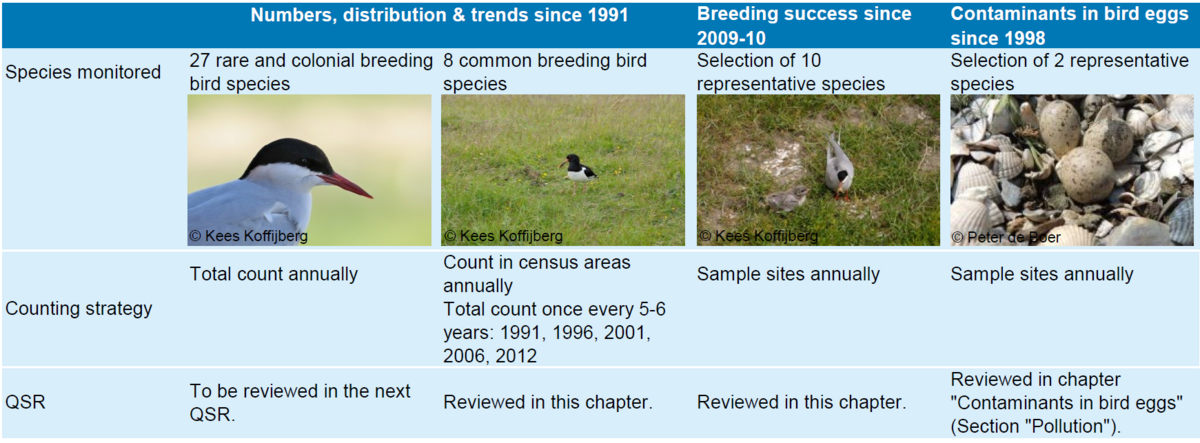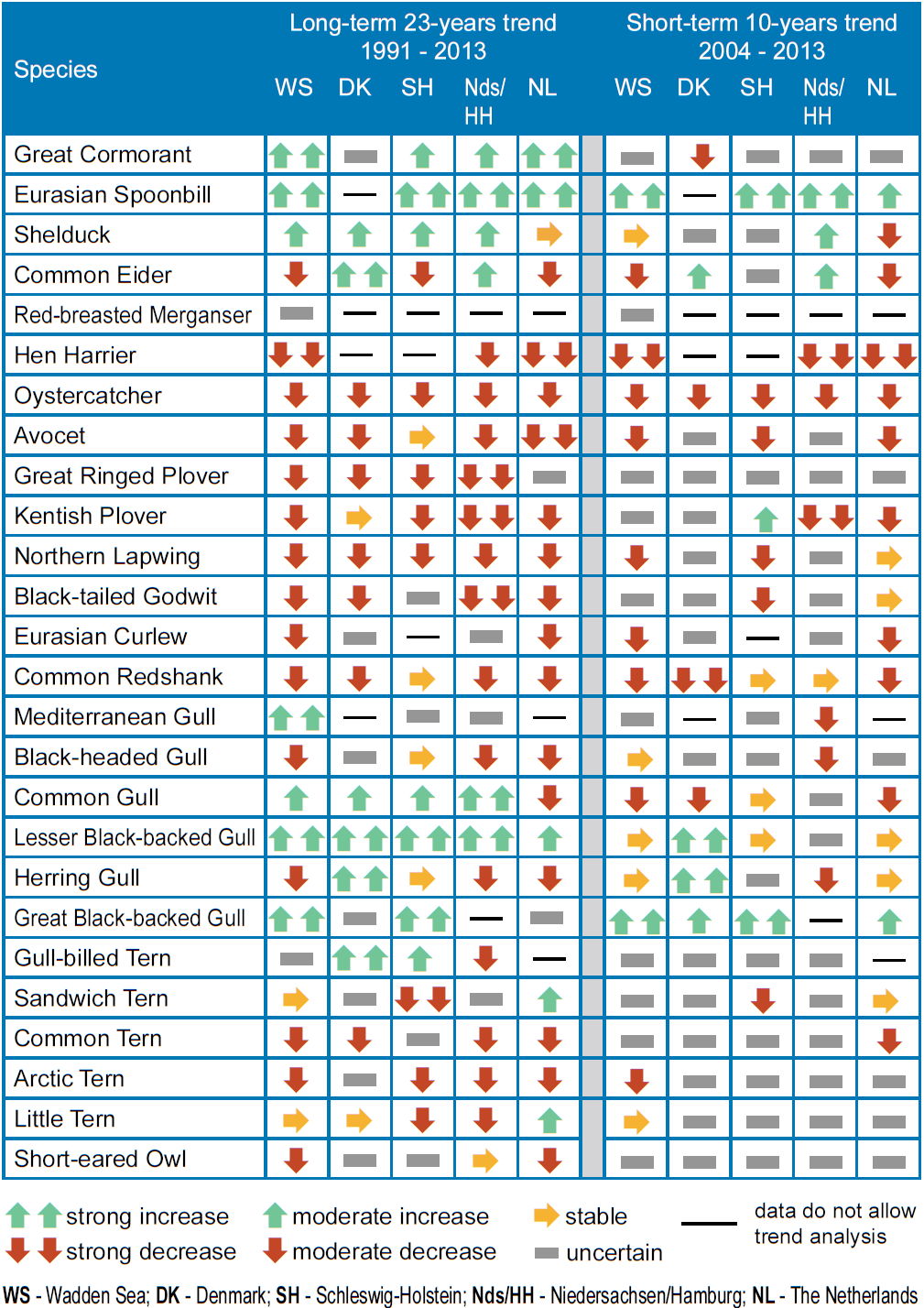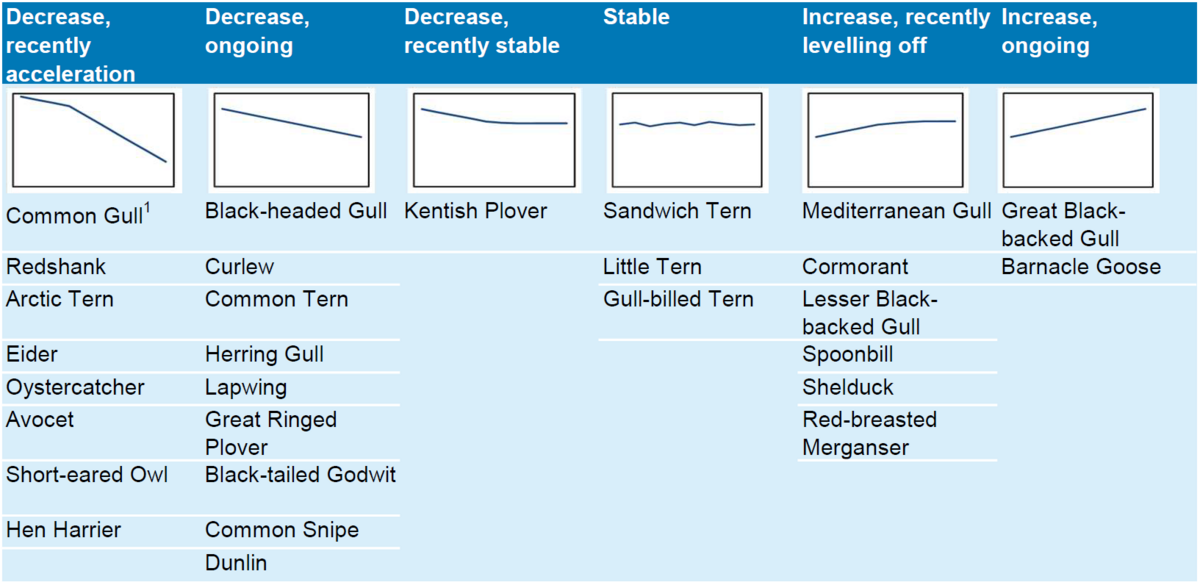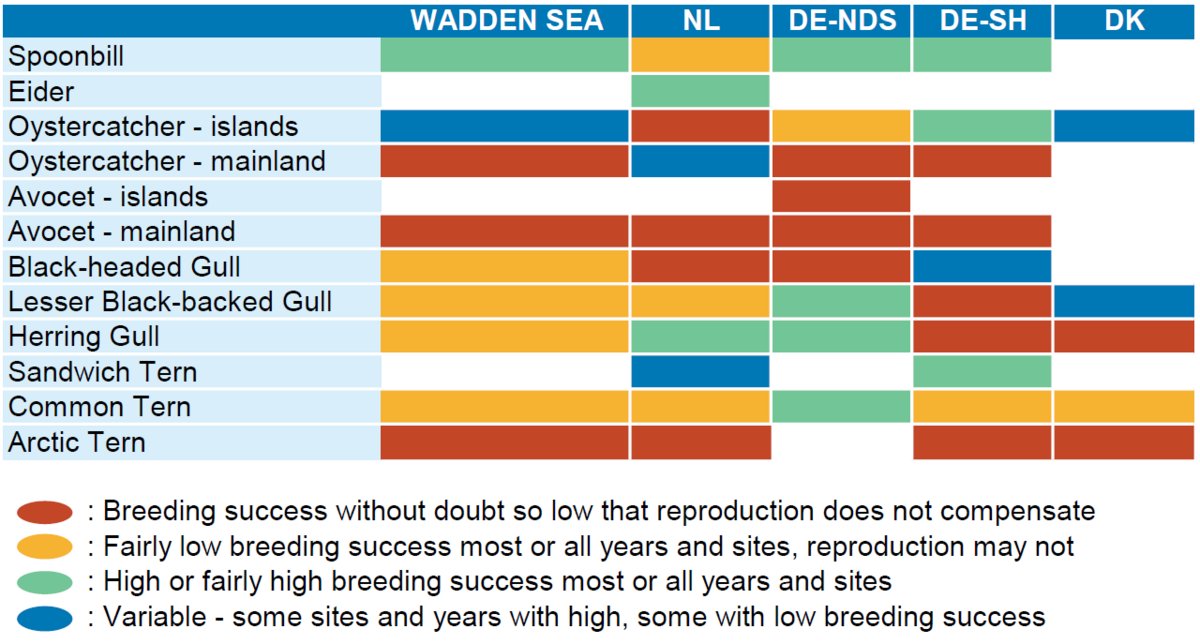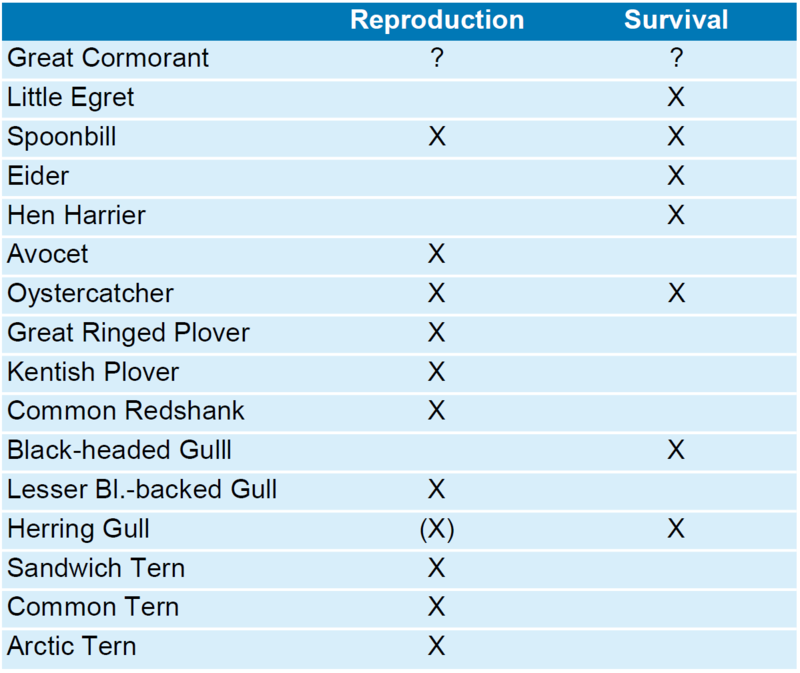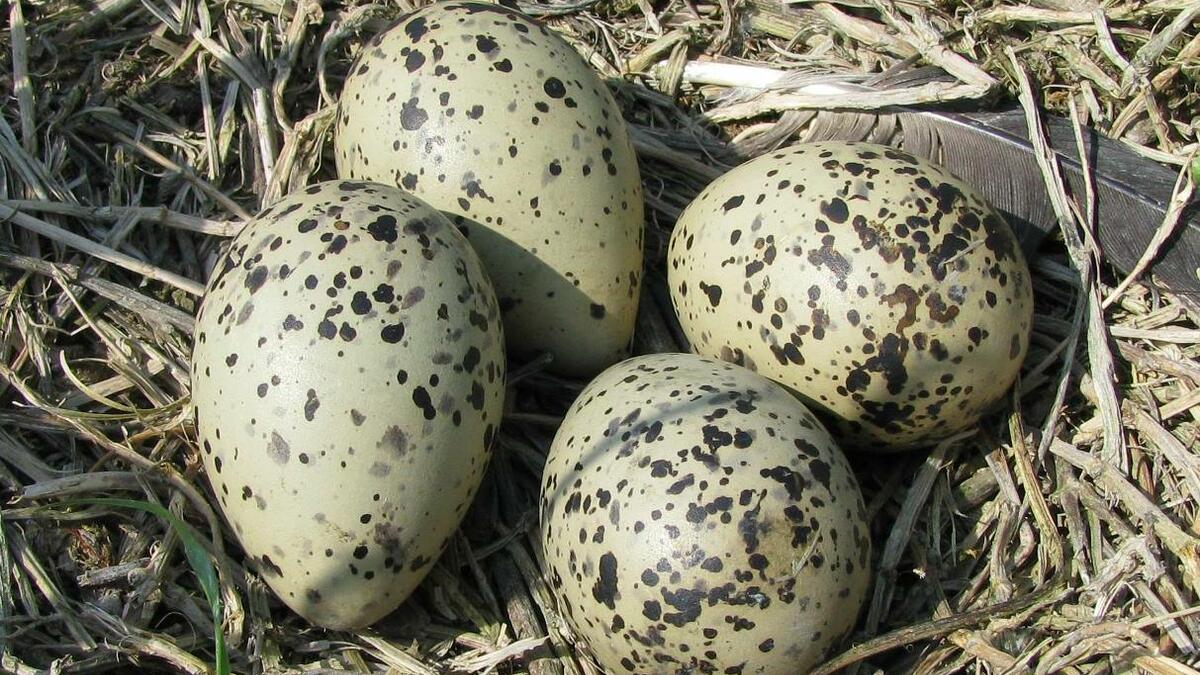
Photo: Peter de Boer. Oystercatcher eggs.
Breeding birds
K. Koffijberg, J. Frikke, B. Hälterlein, K. Laursen, G. Reichert & L. Soldaat
Published 2017
1. Introduction
The Wadden Sea hosts large numbers of coastal breeding birds. For several species, the area supports an important share of the breeding population in northwestern Europe, for instance Shelduck, Oystercatcher, Avocet, Redshank, Black-headed Gull, Lesser Black-backed Gull, Sandwich Tern and Common Tern. For Spoonbill and Gull-billed Tern, the Wadden Sea even represents the main (in Gull-billed Tern single main) breeding area in northwestern Europe. Breeding birds are attracted by a combination of suitable breeding habitat in salt marshes, coastal wetlands, dune areas and coastal grasslands and abundant food stocks in the intertidal area. Especially colonially breeding gulls and terns, also use the North Sea for feeding.
Compared to migratory and wintering birds, breeding birds also heavily depend on the non-intertidal part of the Wadden Sea, including coastal wetlands and coastal grasslands. Management of these sites, or other developments occurring there (e.g. predation risk) are all potential drivers for the fate of breeding bird populations in the Wadden Sea. In addition, similar to migratory and wintering birds, they depend on food resources found in the intertidal area. In general terms, however, breeding birds are more susceptible to factors operating in the "terrestrial" part of the Wadden Sea. As shown recently in an international comparison of flyway trends, severe declines in breeding bird populations in the Wadden Sea may also have affect numbers in the entire flyway (van Roomen et al., 2015; see also report "East Atlantic Flyway"). Information on trends and distribution of breeding birds thus not only supports local management issues, but also help to understand patterns observed in international flyway numbers.
Monitoring of breeding birds within TMAP has been carried out for a selection of coastal breeding birds since 1991 and is co-ordinated by the Joint Monitoring Breeding Bird group in the Wadden Sea (JMBB). Since 2009-2010, monitoring of breeding success has been added as TMAP parameter (Thorup & Koffijberg, 2015). Fieldwork is carried out by a large number of volunteers and staff from various nature conservation agencies and local site managers. Results have been published in extensive reports (e.g. Koffijberg et al., 2006) and nowadays are presented by biennial progress reports (e.g. Koffijberg et al., 2015a). Wadden Sea data is used for the implementation of the EU-Bird Directive and its Natura 2000 network. More recently, the bird data (both data on abundance and breeding success) has also been incorporated in the biodiversity indicators of the Marine Strategy Framework Directive (Cook et al., 2014; OSPAR Commission, 2016), in order to assess the environmental status of marine areas. Due to the ongoing declines observed in many species, a special breeding bird action plan was issued in 2016 and adopted by the Wadden Sea Board (JMBB, 2016).
This QSR report summarises current knowledge on status and trends in numbers of coastal breeding birds in the Wadden Sea (1991-2013), and makes a comparison with previous Quality Status Reports.
2. Status and trends
Data collection
The TMAP monitoring strategy for breeding birds distinguishes between common, rare and colonial breeding birds. Of the 35 breeding bird species monitored, most species are counted annually in the entire Wadden Sea to retrieve yearly total counts. Abundant and widespread species like Shelduck, Oystercatcher and Redshank are counted annually in about 350 specific census areas well-distributed over the Wadden Sea. Once every six years a total count is carried out for all TMAP-breeding bird species, to monitor changes in total population size and distribution. The latest total count was accomplished out in 2012. Besides numbers and distribution, breeding success has been monitored since 2009-10 (in the Dutch Wadden Sea from 2005 onwards as part of a national scheme). Recorded are hatching success (fate of clutches, for most species) and fledging success (number of fledged chicks per pair, all species). This monitoring scheme focuses on 10 representative species, incl. Spoonbill, Eider, Avocet, Oystercatcher and selected colonial gull and tern species. Table 1 gives an overview of all TMAP-projects that involve bird monitoring, including projects that are not co-ordinated by JMBB.
All fieldwork is carried out according to standardised guidelines (Hälterlein et al., 1995; Koffijberg et al., 2011). Usually, counts are made from land, but especially in the German Wadden Sea, also aerial surveys are used to determine colony size of species like Great Cormorant, Spoonbill and Sandwich Tern. Recently, also first experiences with drones have been made. Frequently, so-called Quality Assurance Meetings (QAM) are organised by JMBB during the breeding season (e.g. Blew, 2003), to educate new counters, discuss pitfalls in counting methods and experiment with new methods. The latter included e.g. the use of drones and methods how to distinguish nests from Herring Gull and Lesser Black-backed Gull, based on prey remains found in the nest territory.
Since 2012, calculations of trends in numbers have been made by Statistics Netherlands (CBS), in close collaboration with Sovon Vogelonderzoek Nederland (data processing and database management). For this purpose, the setup for the Dutch breeding bird monitoring scheme (Boele et al., 2016) was adapted to achieve trilateral trend calculations. Trends are basically determined for seven regions within the Wadden Sea (e.g. distinguishing between estuaries and non-estuaries), and then combined for each of the four countries (Denmark, Schleswig-Holstein, Lower Saxony/ Hamburg, the Netherlands) or for the entire Wadden Sea. For these country- and Wadden Sea trends, trends for abundant species that are not covered by annual counts, are weighted according to their distribution during the total count in 2006. In this way, also the difference in number of sample areas where abundant species are surveyed is corrected for. Details of trend calculations are given by Koffijberg et al. (2015a).
Table 1. Overview of bird monitoring carried out in the framework of TMAP. Details on the trilateral monitoring schemes are given by Becker et al. (2001), Koffijberg et al. (2015a) and Thorup & Koffijberg (2015) (Photos: Kees Koffijberg, Peter de Boer).
Trends in numbers in the Wadden Sea
For 29 out of 35 breeding bird species monitored, trends in numbers between 1991 and 2013 are calculated for the entire Wadden Sea (Figure 1, Table 2). For most species (17 out of 29; 59 %) significant declines have been recorded since 1991. Declining species are generally found among all species groups, including species for which the Wadden Sea hosts internationally important numbers, like Redshank, Oystercatcher, Common Tern and Avocet. Decreases in Dunlin (of the subspecies schinzii) implicate potential loss of this species in its southernmost breeding area in northwestern Europe. In general, coastal waders, including Ruff (which numbers are too small to make trend calculations), have declined in the past decades and numbers in all wader species have gone down significantly, for Common Snipe even with more than 10 % per year. Also the raptor species in the Wadden Sea, Hen Harrier and Short-eared Owl, both mainly breeding in dune areas, are found among the species with highest rate of decline.
On the other hand, nine species have increased since 1991. These mainly consist of some colonial breeding birds like Spoonbill, Great Cormorant, Lesser Black-backed Gull and Common Gull. Both Barnacle Goose and Mediterranean Gull have shown range expansions in large parts of northwestern Europe in the past decade, which is also reflected by their breeding numbers in the Wadden Sea. Also Spoonbill is still expanding its breeding population, mainly in the German part of the Wadden Sea. Stable trends were recorded in Little Tern, Sandwich Tern and Gull-billed Tern (but some of these species experienced declines before the trilateral monitoring started in 1991).
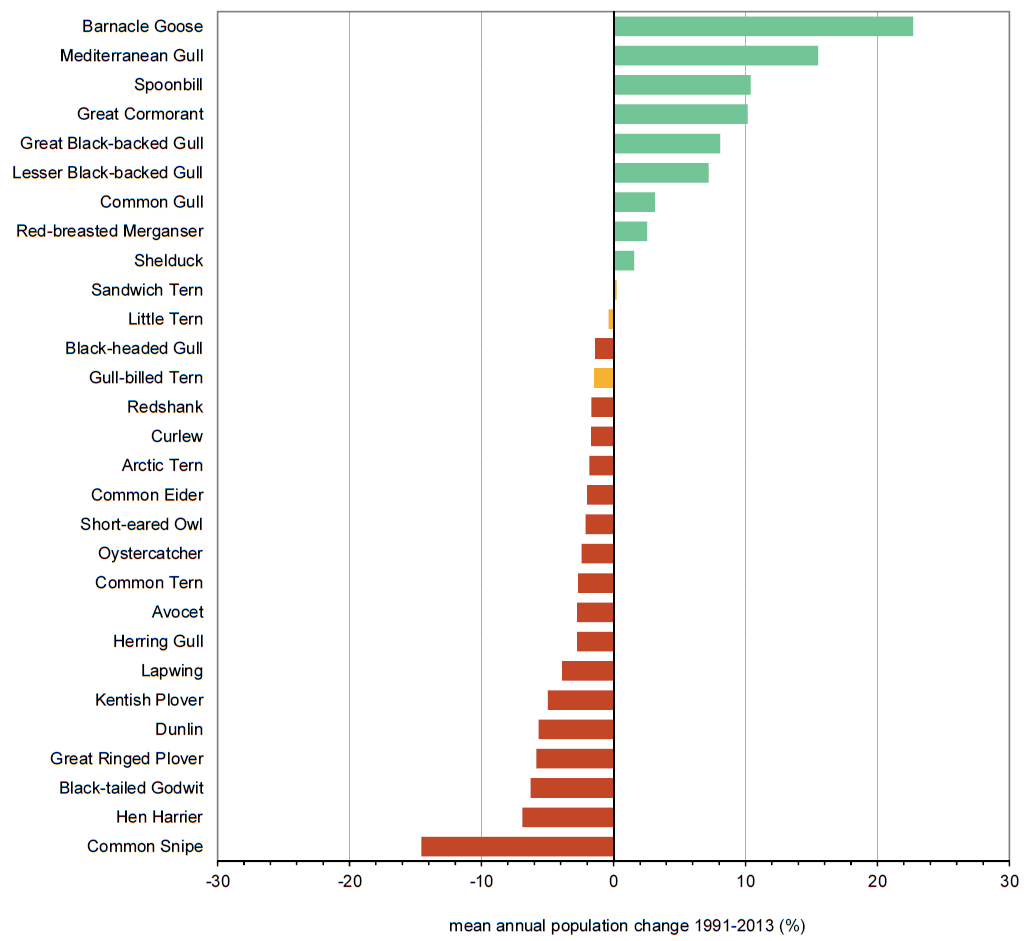 Figure 1. Summary of breeding bird trends in the Wadden Sea since 1991. Shown is the mean annual change in numbers (in %), ranked from increasing species (top) to declining species (bottom). For Little Egret, Wigeon, Pintail, Ruff, Turnstone and Little Gull no trends could be calculated due to small numbers and/or erratic breeding occurrence.
Figure 1. Summary of breeding bird trends in the Wadden Sea since 1991. Shown is the mean annual change in numbers (in %), ranked from increasing species (top) to declining species (bottom). For Little Egret, Wigeon, Pintail, Ruff, Turnstone and Little Gull no trends could be calculated due to small numbers and/or erratic breeding occurrence.
Table 2. Summary of breeding bird trends for the entire Wadden Sea and the four countries. Shown are trends for the entire period 1991-2013 and the last 10 years, to allow a comparison of long-term and short-term trends.
When comparing trends for the entire period 1991-2013 with those from the last ten years, it becomes obvious that in eight species, the rate of decline has accelerated recently (Table 3). This includes Common Gull, which upward long-term trend turned into a decline more recently. Furthermore, this group includes some common Wadden Sea breeders like Redshank, Eider, Oystercatcher and Avocet. Also Hen Harrier and Short-eared Owl have accelerated their decline recently, mainly because earlier decreases in the Dutch part of the Wadden Sea were recently followed by similar developments in Lower Saxony/ Hamburg.
In one declining species, numbers stabilised recently (Kentish Plover), whereas most other species numbers continued to decrease with the same rate as in the long term. Most of the increasing species also levelled off their rate of increase. Only Greater Black-backed Gull and Barnacle Goose keep thriving at a similar level and will probably expand further.
Table 3. Summary of different trend patterns in breeding birds in the Wadden Sea in 1991-2013, with comparison of long term (1991-2013) and short term (2004-2013) patterns.
Regional patterns
The Wadden Sea experiences different environmental conditions and in addition some species have their northern or southern breeding range in the area. Hence, it is not surprising that the general breeding bird trends described in the previous section do not apply to all parts of the Wadden Sea. Indeed, a pronounced difference exists between the western part of the Wadden Sea (i.e. Netherlands, Lower Saxony/ Hamburg) and the northern part of the Wadden Sea (Schleswig-Holstein and Denmark) (Figure 2). In the western part, more species experience declines, whereas in the northern part increasing and decreasing trend patterns occur more equally. This is demonstrated by stable numbers of Avocet, Redshank, Black-headed Gull and Arctic Tern in Schleswig-Holstein (vs. declines/fluctuating in all other parts). Also Common Tern tends to perform better in Schleswig-Holstein than in other parts of the Wadden Sea, benefitting from the good population development of their main prey, Smelt (Osmerus eperlanus) in the River Elbe (Hennig et al., 2016). Both the Schleswig-Holstein and Danish part of the Wadden Sea have fluctuating or increasing numbers of Herring Gull, whereas in the Netherlands and Lower Saxony this species has undergone a significant long-term decline. The Danish Wadden Sea also still supports good numbers of Kentish Plover, a species which has disappeared from many other sites elsewhere in the Wadden Sea. In Schleswig-Holstein this species has stabilised very recently (Cimiotti et al., 2016). Little Tern is the only species which shows a more positive trend in the western part of the Wadden Sea. Sandwich Tern on the other hand, is only one of the few species that shows a significant decline in the Wadden Sea of Schleswig-Holstein, whereas it is fluctuating in other countries (stable at the level of the whole Wadden Sea). This species is also known to switch breeding sites easily within the Wadden Sea.
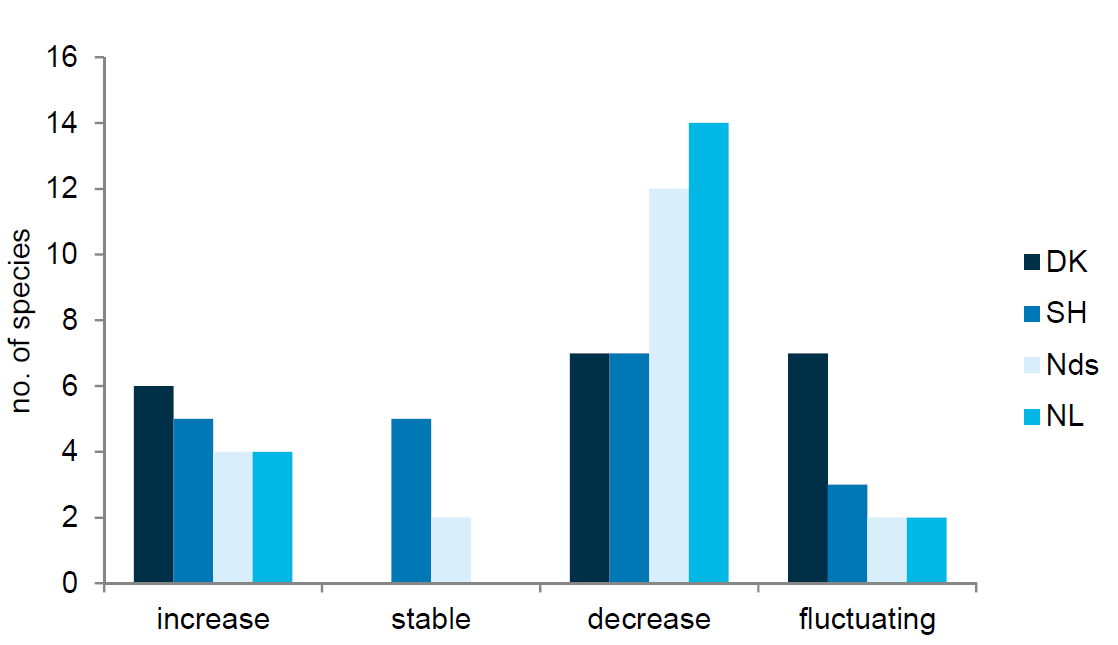 Figure 2. Summary of long term-trends in breeding birds in the Wadden Sea for the countries separately (NL = Netherlands, Nds = Lower Saxony/ Hamburg, SH = Schleswig-Holstein, DK = Denmark). Only species for which trends were available for all countries (N = 20) were taken into account to allow a comparable overview.
Figure 2. Summary of long term-trends in breeding birds in the Wadden Sea for the countries separately (NL = Netherlands, Nds = Lower Saxony/ Hamburg, SH = Schleswig-Holstein, DK = Denmark). Only species for which trends were available for all countries (N = 20) were taken into account to allow a comparable overview.
On a more regional level, a comparison of trends has highlighted several local patterns, which eventually may also provide clues for causes that are responsible for the observed trends, especially when compared to other parameters or management regimes (Koffijberg et al., 2015a). Striking examples of such patterns are stable numbers of Avocet and Oystercatcher in areas in or close to the Weser-Elbe estuary (Oystercatcher also within the Ems-Dollard estuary) and increasing Lapwing and Redshank numbers in the eastern part of the Dutch Wadden Sea.
Breeding success
As a TMAP parameter, breeding success in the Wadden Sea was implemented in 2009-2010. On a national scale however, data on breeding success were collected much earlier, e.g. specific projects in Lower Saxony (Common Tern, Herring Gull/Lesser Black-backed Gull), investigations on hatching success of Oystercatcher in Schleswig-Holstein since the beginning of the 1990s, and the national monitoring scheme on breeding success that started in the Dutch Wadden Sea in 2005 as part of management and evaluation of shellfish fisheries.
Assessment of breeding success shows that especially Oystercatcher, Avocet and Artic Tern indeed have a very low breeding success, which is insufficient to maintain the population even at a stable level. All three species have shown an acceleration in the rate of decline recently (see Table 4), which is likely to be associated with the persistent low breeding success. Also Black-headed Gull, Lesser Black-backed Gull and Common Tern have an overall poor breeding success. Of these species, only Lesser Black-backed Gull has increased until now, albeit the rate of increase has levelled-off (Table 3).
When compared to the longer-term data from the breeding success monitoring in the Dutch Wadden Sea (2005-2013; Koffijberg et al., 2015b), most of the assessments made in Table 4 could be confirmed. On a longer term, however, also Common Eider has a lower reproduction than needed for a stable population whereas recently Sandwich Terns has faced low productivity in its largest colony on the island of Griend. Moreover, trends in reproduction in the Dutch Wadden Sea show that in many species, breeding success has declined between 2005-2013, although only statistically significant in Spoonbill and Black-headed Gull. In Spoonbill, this is regarded as a response to the increased population growth, so-called density-dependence regulation (Lok et al., 2009). Several studies have pointed out that decreasing trends in breeding success are not a recent phenomenon and already started in the late 1990s or early 2000s, e.g. in Oystercatcher (van der Jeugd et al., 2014) and Common Tern (e.g. Dänhardt & Becker, 2010). But due to the fact that coastal breeding birds are long-lived species, breeding failure will usually affect numbers with a delay of several years.
Van der Jeugd et al. (2014) reviewed demographic drivers of population changes in Wadden Sea birds, and concluded that for most breeding bird species poor breeding success was an important driver for declines observed in the past decades. This also applied to species, which are not covered in the current breeding success monitoring, such as Great Ringed Plover, Kentish Plover and Redshank. Only in few species, changes in annual survival of adult and subadult birds played an important role in the decrease in numbers, e.g. in Black-headed Gull (1st year-survival) and Herring Gull. In Oystercatcher both poor breeding success and lower annual survival rates affect the size of the breeding population, whereas in Eider condition of breeding females may limit the performance of the breeding population. Both Oystercatcher and Eider might also be affected by the situation in the Wadden Sea in winter, leading to lower condition in the breeding season. In most other species, it is likely that the low breeding success is caused by factors operating in the Wadden Sea during the breeding season.
Table 4. Assessment of breeding success in the Wadden Sea, as recorded by the TMAP parameter breeding success in 2009-2012 (Source: Thorup & Koffijberg, 2015).
3. Assessment
Current status in breeding birds
Breeding bird numbers in the entire Wadden Sea have experienced very mixed fortunes since the start of the monitoring in 1991. Today, only a minority of bird species show stable or increasing numbers, for instance some colonial breeders. Some of them have shown an expansion of their breeding range in NW-Europe, and a successive increase in the Wadden Sea, e.g. Spoonbill and Mediterranean Gull. The same also applies to Barnacle Goose, which has increased its flyway population manifold since the 1970s, in line with the general increase in many herbivorous waterbirds. The majority of breeding bird species, however, has been subject to significant declines during the period 1991-2013. Recent results show that 17 out of 29 breeding bird species for which good monitoring data is available, the overall trend in this period is pointing downwards. Among them are bird species for which the Wadden Sea hosts an important share of the flyway population, e.g. Redshank, Oystercatcher and Avocet. In the group of species showing "steady" declines, many breeding birds of coastal grasslands are found, for instance Lapwing and Black-tailed Godwit. Common Snipe, Dunlin and Ruff have become extremely rare, and are likely to become extinct as breeding bird species in the Wadden Sea in near future. Several breeding bird species have also accelerated their rate of decrease in the last ten years of monitoring, suggesting that breeding opportunities have not improved recently. This especially refers to some typical Wadden Sea breeders, like Redshank, Oystercatcher, Arctic Tern, Eider and Avocet. The tendency for downward trends becoming dominant is clearly shown by the comparison of previous QSR-assessments, which expresses a growing number of birds which are subject to decreases (Figure 3). Apart from species showing long-term declines, the growing number species showing declines seems to be partly at the expense of stable numbers.
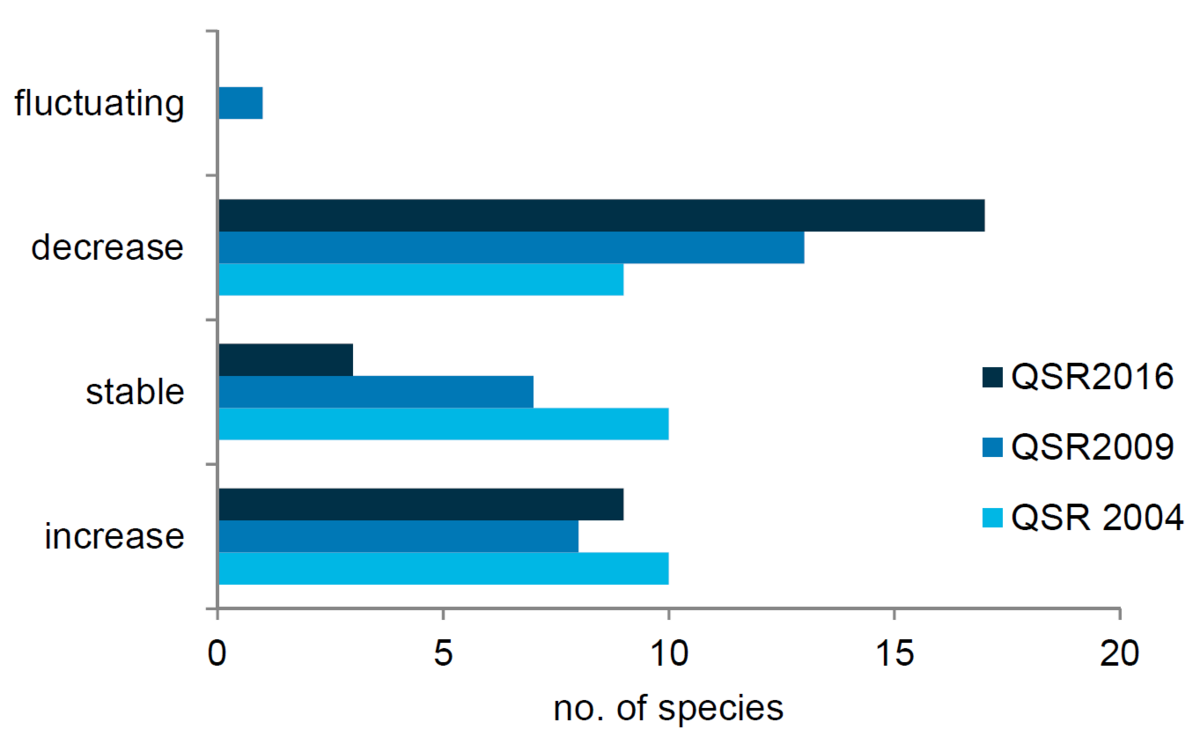 Figure 3. Summary of trends in breeding birds in the Wadden Sea, assessed during QSR 2004 (Essink at el., 2004), QSR 2009 (Marencic & de Vlas, 2009) and this QSR. Non-significant trends have been categorized as "fluctuating". Breeding bird data series for which trends were assessed refer to 1991- 2001 (QSR 2004), 1991-2006 (QSR 2009) and 1991-2013 (QSR 2016).
Figure 3. Summary of trends in breeding birds in the Wadden Sea, assessed during QSR 2004 (Essink at el., 2004), QSR 2009 (Marencic & de Vlas, 2009) and this QSR. Non-significant trends have been categorized as "fluctuating". Breeding bird data series for which trends were assessed refer to 1991- 2001 (QSR 2004), 1991-2006 (QSR 2009) and 1991-2013 (QSR 2016).
Drivers for population changes
Poor breeding success has been identified as an important driver for the declining breeding bird populations, as was observed from results from the ongoing monitoring of breeding success in the Dutch Wadden Sea (from 2005 onwards) and breeding success data collected within TMAP since 2009-2010. Especially in species like Oystercatcher, Avocet and Arctic Tern, there is a clear association between low breeding success, the general decline in numbers and the recent acceleration in the rate of decline (Thorup & Koffijberg, 2015). In their review of population demography of breeding birds in the Dutch Wadden Sea, Van der Jeugd et al. (2014) concluded that for most breeding bird species, poor reproduction rates were the single most important factor causing population declines (Table 5). Only in Little Egret, Eider, Hen Harrier, Black-headed Gull and Herring Gull, changes in annual survival were more important than breeding success. Given the similarities in population demography in the Dutch Wadden Sea and the German and Danish Wadden Sea (Thorup & Koffijberg, 2015; Koffijberg et al., 2015b), it is likely that these conclusions will also apply on the scale of the entire Wadden Sea.
Causes for failure are not always known in detail and also inter-related, but predation risk and flooding were among the most frequent causes observed during monitoring of breeding success (Thorup & Koffijberg, 2015; Koffijberg et al., 2015b). Other causes include starvation by lack of food resources and unfavourable weather, locally also trampling by livestock-grazing and increased agricultural pressure in coastal grasslands (leading to deterioration of breeding habitat or breeding failure). Predation especially occurs along the mainland coast, where mammalian predators like Red Fox and Beech Marten (locally also invasive species like Mink and Raccoon Dog) are more abundant than on islands (except for islands with a permanent barrier-connection to the mainland, like Sylt and Rømø, but recently also some of the Hallig Islands, Oland, Langeness and Nordstrandischmoor in Schleswig-Holstein). Predation is also assumed to play an important role in the process of colonial breeding birds deserting the mainland Wadden Sea coast in the Dutch Wadden Sea (Bos et al., 2015; Koffijberg et al., 2015b).
Flooding has been observed both on islands and the mainland coast as a factor of importance for all breeding bird species that breed on sites exposed to tidal influence. It is caused by an increase in catastrophic flooding events in the past decades, as a result of sea level rise and climate change (van de Pol et al., 2010ab). In some salt marsh areas, breeding birds may choose between two evils: either breeding on the higher elevated salt marsh close to the dike where risk of (mammalian) predation is higher (Cervencl et al., 2011), or breeding on the fringe of salt marsh and mud flats or on exposed sandy islets, which is likely to increase the risk of flooding and loss of clutches and broods. In Oystercatcher, it has been shown that the most productive birds on the island of Schiermonnikoog do breed exactly in this lower zone of the salt marsh (van de Pol et al., 2010), which makes the impact of flooding, at least on a local scale, even more pronounced. Only in salt marshes where higher parts are further from the dike, breeding birds may find a more comfortable position.
An aspect that is not well covered and assessed by the monitoring scheme on breeding success, is the role of food limitations. Especially in colony-breeding birds (incl. Avocet), it was observed that several species face problems during the chick-rearing period and not so much in the incubation period (Stienen et al., 2009; Camphuysen, 2013; Thorup & Koffijberg, 2015), which may be an indication that food resources might be an important constraint (and on turn may also increase risk of predation). In Eider, poor condition of females prior to the breeding season is thought to play a role in breeding performance in the Wadden Sea (Koffijberg & Smit, 2013) and also for Eiders wintering in the Wadden Sea and breeding in the Baltic Sea (Laursen & Møller, 2014). The background for the poor body condition in Eiders before breeding is assumed to be low carrying capacity due to low mussel stock followed by low nutrient concentration in the Wadden Sea during the last two decades (Laursen & Møller, 2014). In case of shellfish-eating or fish-eating bird species, these issues may be linked to (former) fishery effort in the Wadden Sea and the coastal zone of the North Sea itself (Ens et al., 2004; Laursen et al., 2009), but may also well reflect changing patterns in food availability caused by changing climatological patterns, as has been observed for pelagic fish stocks (e.g. Dänhardt & Becker, 2010). Contaminants in bird eggs are currently assumed not to have an impact on breeding success of coastal breeding birds (Dittmann et al., 2009).
Table 5. Review of demographic processes causing Wadden Sea breeding bird populations to change (i.e. in most cases a decline), based on a review for the Dutch Wadden Sea (from Van der Jeugd et al., 2014). X indicates what demographic parameter contributed most to the observed population change.
Target evaluation - Wadden Sea Plan
Stable or increasing numbers and distribution taking into account that abundance of species is in line with prevailing physiographic, geographic and climatic conditions
This target is not met, as 59 % of breeding bird species for which good monitoring data was available show declining numbers. In addition, also numbers of Ruff have declined, but numbers are so small now, that trend calculations are not possible. The number of declining species (and in some species the rate of decline) has grown recently, and for most species these are not connected to prevailing physiographic, geographic and climatic conditions. However, some issues causing low numbers of breeding birds may be related to general changes in the ecosystem, caused by e.g. climate change, as was shown with availability in suitable fish populations for terns, related to seawater temperature (Dänhardt & Becker, 2010). Those species showing changes in their breeding range are also species that thrive and have expanded their breeding range in northwestern Europe (e.g. Barnacle Goose, Spoonbill, Mediterranean Gull).
Breeding success and survival determined by natural processes
This target is not met, as many breeding birds fail to reproduce on a level that should maintain at least a stable population. Breeding success has only been monitored in a selection of ten breeding bird species within TMAP. Results point at a lack of reproduction in seven to eight of the ten species monitored. Data from the Dutch Wadden Sea, show that poor reproduction is apparent in more species, e.g. also Great Ringed Plover, Kentish Plover and Redshank (see Van der Jeugd et al., 2014). Data from coastal grasslands in Denmark indicates that meadow birds (e.g. Lapwing, Black-tailed Godwit) suffer low reproduction rates as well (Thorup & Laursen, 2008), although some of these species do not show declines all over the Wadden Sea. Overall, it can be concluded that a wide range of breeding bird species (reflecting different species groups and food guilds) in the Wadden Sea fail to produce enough offspring to keep their populations stable.
Survival is currently not monitored within TMAP. The review by Van der Jeugd et al. (2014) for the Dutch Wadden Sea shows that some Wadden Sea breeding birds have been subject to changing survival rates, like Little Egret, Eider, Hen Harrier, Black-headed Gull and Herring Gull. Survival rates of adult and subadult birds have further attributed to observed population changes in Spoonbill and Oystercatcher. At least for Little Egret it has been shown that the species is limited by natural variation in winter weather. This species reaches the northern fringe of its breeding range in the Wadden Sea, and harsh winters after 2008/09 have thrown back breeding numbers to levels at the time the area was colonized. For Spoonbill, changes in survival have been attributed to factors operating during spring migration and density-dependent factors at the breeding grounds (Lok, 2013). For most of the other species, human-related processes have been put forward as main drivers for observed changes in survival, all associated with food availability, including closure of rubbish dumps for gulls (van der Jeugd et al., 2014; Camphuysen, 2013).
Breeding, feeding, moulting and roosting sites supporting a natural population
Given the evidence described for the earlier targets for breeding birds, not all breeding sites support a natural population, as in many species external factors are responsible for e.g. the low breeding success reported for many breeding bird species. Some issues, like agricultural management (mainly in coastal grasslands) and facilitation of mammalian predators to former islands are the most pronounced human interventions causing breeding bird numbers to decline and thus indicate that the target is not met. The same may also apply to fisheries or other human exploitation, but there is currently no comprehensive research going on to quantify the impact of such activities.
Undisturbed connectivity between breeding, feeding, moulting and roosting sites
This target is mainly connected to migratory birds (see report "Migratory birds").
Fluctuations in food stocks determined by natural processes
In the past decades, climatological changes and changes in nutrient input have affected the feeding possibilities for coastal breeding birds (see reports "Climate Change" and "Eutrophication"). These may also affect part of the trends currently observed (especially regarding food resources for breeding birds). However, given the differences in trends within the Wadden Sea, often observed at close range, there is evidence that also other factors operate that are responsible for many of the downward trends, like different management regimes. Further specification of this is only possible with a more comprehensive analyses of the available data, which is beyond the scope of this QSR.
Habitat, food stocks and connectivity between habitats supporting a favourable conservation status
This target is not met, as too many species, breeding in different habitats and representing different food guilds are currently in decline.
4. Recommendations
Recommendations for monitoring and research
The current monitoring of breeding birds is well able to keep track on changes in breeding bird populations in the Wadden Sea and has clearly shown the trend of breeding bird populations between 1991 and 2013. The target addressing numbers and distribution thus can be reviewed for nearly all coastal breeding bird species (see Figure 1 and 3). Only few monitored species occur in very small numbers (see Figure 1), making proper trend assessments difficult. The recent improvements in data processing and trend calculations made by Statistics Netherlands have also expanded possibilities to look into regional trends in more detail. Further exploration of these data could provide clues why some species show contrasting patterns within the Wadden Sea, sometimes at close range, and could also address further research. As results of the monitoring are published biennially in progress reports and made available online by the Common Wadden Sea Secretariat, they are easily shared among the Wadden Sea community and other relevant institutions. In some parts of the Wadden Sea (notably in the Netherlands and Denmark), fieldwork depends on the effort of volunteers, so feedback to them is essential to keep participation in fieldwork at a high level.
Another aspect of data handling that could be improved yet is the data organisation of breeding success data. This parameter was introduced within TMAP in 2009-10 (however not implemented in Denmark). But due to a lack of resources, it still lacks a well-organised data structure (similar to the breeding bird abundance data) that allows regular reviews of the data collected. JMBB has recognised this aspect already, and before the breeding season 2018 both data entry and database will be shared and standardised among all countries. This also allows process the backlog in data collection after the first review from Thorup & Koffijberg (2015). Secondly, the manual for fieldwork on breeding success is still based on provisional guidelines. Based on the experiences collected so far, a final version would help to improve methodological standards and harmonisation of methods within the Wadden Sea.
With the addition of the parameter breeding success in TMAP in 2009-2010, major improvements towards evaluating the target on breeding success and survival could be made in this QSR. Indeed, the monitoring data collected on breeding success so far, point out very well which kind of problems coastal breeding birds in the Wadden Sea are currently faced with. Survival is still lacking in the set-up of trilateral monitoring (see Table 1). Van der Jeugd et al. (2014) were able to compare both reproduction and survival for coastal breeding birds in the Dutch Wadden Sea. They concluded that in most species, reproduction was an important driver, causing breeding populations to change (see Table 5). In fewer species, also survival contributed to the observed trends. It is still not clear yet, if these findings also apply to other parts of the Wadden Sea, but ringing data are also available for many species in Germany and Denmark (kept by the national ringing centres), thus a similar assessment made for the Dutch Wadden Sea could assess the demographic status of breeding birds in the German and Danish Wadden Sea as well. Moreover, as ringing of chicks is used as a tool to determine breeding success, the available data pool for such calculations will even improve in future. A first review of demographic patterns in breeding birds in the trilateral Wadden Sea should not only review existing data, but also find out what effort of ringing (in terms of focus species and sample) is needed for a regular review (e.g. with an interval of once every 6 or 12 years, matching with the interval of the total counts).
So far, breeding bird data have been used in several projects dealing with salt marsh management (e.g. Laursen & Hald, 2012; Erb, 2012; Maier, 2014; Mandema, 2015) and there has been an increased effort in combining salt marsh vegetation data and breeding bird abundance since the last QSR. Still, however, nearly all projects are carried out with national datasets, whereas trilateral datasets would expand the possibilities to explore patterns observed in salt marsh development and breeding bird communities. Other aspects of salt marsh management and interactions with other species, e.g. the presumed impact of late-staging geese on salt marsh vegetation and breeding birds (e.g. Esselink, 2000) have still not been subject of specific research, despite the debates going on about high abundance of geese and their presumed impact on e.g. meadow bird communities.
Other aspects of research that have not been taken up so far very well, is specific research to the backgrounds of the overall population declines in Wadden Sea breeding birds. It should be noted, that the monitoring data mainly signalize trends and patterns going on. By combining and comparing data, some processes behind the observed trends could be pointed at, but often more detailed research is needed to unravel the mechanisms going on and allow a more direct approach in management measures. The aspect of predation for instance, is difficult to manage, as a direct measure (predator control) might not be the most sustainable in the long term, but data to implement a sound predation management (which is much broader than just reducing the number of predators, involving e.g. also habitat management) lacks the knowledge on the occurrence and behaviour of the predators itself (see e.g. Meisner et al., 2014). In fish-eating birds like terns, small fish monitoring around the breeding colony would help to understand the performance of the colonies in different years, as done at the moment in Schleswig-Holstein (Hennig et al., 2016). At the moment, fish surveys mainly focus on commercial fish stocks.
Recommendations for management
In a recently published framework for action towards improvement of breeding conditions for breeding birds in the Wadden Sea (Koffijberg et al., 2016), several management measures have been proposed to stop or slow down the ongoing declines. These measures were first discussed during a special workshop in Wilhelmshaven in spring 2013, among bird experts and site-managers. Meanwhile, the framework has been adopted by the Wadden Sea Board (Koffijberg et al., 2016), and in the Dutch Wadden Sea, its implementation has been taken up by the Programme Rich Wadden Sea.
5. Summary
The Wadden Sea hosts large numbers of coastal breeding birds and for several species supports an important share of the flyway population. They use a network of breeding and feeding sites, both at sea (partly offshore), on the intertidal mud flats, salt marshes, dunes and wetlands behind the seawall. Data from the breeding bird monitoring, carried out in the framework of TMAP, shows that 17 out of 29 bird species have declined since the monitoring started 1991, i.e. they do not meet the targets of the Wadden Sea Plan. This trend is observed among all species-groups, including those species for which the Wadden Sea is an important breeding area, like Redshank, Oystercatcher, Common Tern and Avocet (actually in several of these species, the rate of decline has accelerated recently). Several waders are currently even on the brink of extinction, e.g. the southern race schinzii of Dunlin and Ruff. Also both raptor species that are typical for the Wadden Sea, Hen Harrier and Short-eared Owl, have decreased to very low population levels. In contrast, 9 bird species have shown increases, mainly some colonial breeding birds like Spoonbill, Lesser Black-backed Gull and Common Gull. In some species (e.g. Barnacle Goose) the increase in the Wadden Sea is part of a general range expansion. Stable trends were recorded in Little Tern, Sandwich Tern and Gull-billed Tern (but these species experienced declines before the trilateral monitoring started in 1991). Overall, there are more declining species in the Netherlands and Lower Saxony/ Hamburg, than in Schleswig-Holstein and Denmark.
Data on breeding success, collected within TMAP since 2009 for a selection of species, show that in many coastal breeding birds, reproductive output is rather poor. Notably Oystercatcher, Avocet and Artic Tern have a very low annual breeding success, which is insufficient to maintain the population even at a stable level. This is not a only a recent phenomenon, as several studies have pointed out that decreasing trends in breeding success already started in the late 1990s or early 2000s. This is confirmed by assessments of breeding success in the Dutch Wadden Sea, carried out since 2005.
Predation risk and flooding were among the most frequent causes observed during monitoring of breeding success, albeit causes for poor reproductive performance are not always known in detail, and also interfere with other factors. Additional causes are starvation (lack of food resources) and unfavourable weather, locally also trampling by livestock-grazing and increased agricultural pressure in coastal grasslands. Predation is especially an issue along the mainland coast and at islands which are connected to the mainland coast by barrier dams (including connections to the Hallig islands in Schleswig-Holstein). Flooding has been observed both on islands and the mainland coast as a factor of importance for all breeding species that breed on sites exposed to tidal influence. It is caused by an increase in catastrophic flooding events in the past decades, as a result of sea level rise and climate change. Lack of food resources is suspected at least for colonial breeding birds (gulls and terns), but difficult to assess without specific research. Contaminants in bird eggs are currently assumed not to have an impact on breeding success of coastal breeding birds.
About the authorsK. Koffijberg 1,6, J. Frikke 2,6, B. Hälterlein 3,6, K. Laursen 4, G. Reichert 5,6, L. Soldaat 7 1 Sovon, Dutch Centre for Field Ornithology, Toernooiveld 1, 6525 ED Nijmegen, NL 2 Nationalpark Vadehavet, Tønnisgaard, Havnebyvej 30, 6792 Rømø, DK 3 National Park Authority Wadden Sea Schleswig-Holstein, Schlossgarten 1, 25832 Tönning, DE 4 Aarhus University, Nordre Ringgade 1, 8000 Aarhus C, DK 5 National Park Authority Wadden Sea Lower Saxony, Virchowstr. 1, 26382 Wilhelmshaven, DE 6 Joint Monitoring Breeding Bird group (JMBB) c/o Common Wadden Sea Secretariat, Virchowstr. 1, 26382 Wilhelmshaven, DE 7 CBS Statistics Netherlands, P.O. Box 24500, 2490 HA The Hague, NL |
References
Becker, P.H., Muñoz Cifuentes, J., Behrends, B. and Schmieder, K.R., 2001. Contaminants in Bird Eggs in the Wadden Sea - Spatial and Temporal Trends 1991 - 2000. Wadden Sea Ecosystem No. 11. Common Wadden Sea Secretariat, Wilhelmshaven.
Blew, J. 2003. New ways to test and improve methods – Quality Assurrance Acitivities in breeding bird monitoring. Wadden Sea Newsletter 2003-2: 18-23.
Boele, A., van Bruggen, J., Hustings, F., Koffijberg, K., Vergeer, J.W. & van der Meij, T. 2016. Broedvogels in Nederland in 2014. Sovon-rapport 2016/04. Sovon Vogelonderzoek Nederland, Nijmegen.
Bos, D., Engelmoer, M., Feddema, J. & Koffijberg, K., 2015. Broedvogels van Noord-Friesland Buitendijks en de invloed van verkweldering op hun aantallen. Limosa 88: 31-42.
Camphuysen, C.J., 2013. A historical ecology of two closely related gull species (Laridae): multiple adaptations to a man-made environment. PhD Thesis. University of Groningen, Groningen.
Cervencl, A., Esser, W., Maier, M., Oberdiek, N., Thyen, A., Wellbrock, A. & Exo, K-M., 2011. Can differences in incubation patterns of Common Redshanks Tringa totanus be explained by variations in predation risk? J Ornithol 152: 1033–1043.
Cimiotti, D.V., Ave, M., Hoffmann, H., Leyrer, J., Klinner-Hötker, B., Schulz, R. & Hötker, H. 2016. Möglichkeiten zum Erhalt der Brutpopulationen des Seeregenpfeifers in Schleswig-Holstein – Untersuchungen 2016. Michael-Otto-Institut im NABU, Bergenhusen.
Common Wadden Sea Secretariat (CWSS) (2010): Wadden Sea Plan 2010. Eleventh Trilateral Governmental Conference on the Protection of the Wadden Sea. Common Wadden Sea Secretariat, Wilhelmshaven, Germany.
Cook A.S., Dadam, D., Mitchell, I., Ross-Smith, V.H. & Robinson, R.A., 2014. Indicators of seabird reproductive performance demonstrate the impact of commercial fisheries on seabird populations in the North Sea. Ecological indicators 38: 1-11.
Dänhardt, A. & Becker, P.H., 2010. Die Bedeutung umweltbedingter Verteilungsmuster von Schwarmfischen für Seevögel im Ökosystem Niedersächsisches Wattenmeer. Abschlussbericht des Projektes 53-NWS-41/04 der Niedersächsischen Wattenmeerstiftung. Wilhelmshaven.
Dittmann, T.D., Becker, P.H., Bakker, J., Bignert, A., Nyberg, E., Pereira, M.G., Pijanokowska, U., Stienen, E.W.M., Toft, G.O. & Marencic, H., 2011. The EcoQo on mercury and organohalogens in coastal bird eggs. INBO-report 2011.43. INBO, Brussels.
Ens, B.J., Smaal, A.C. and de Vlas, J., 2004. The effects of shellfish fishery on the ecosystems of the Dutch Wadden Sea and Oosterschelde. Final report on the second phase of the scientific evaluation of the Dutch shellfish fishery policy (EVA-II). Alterra-rapport 1011, RIVO-rapport C056/04, RIKZ-rapport 2004/03. Alterra, Wageningen.
Erb, C., 2012. Effects of grazing regime and vegetation changes on breeding birds in salt marshes of the Schleswig-Holstein Wadden Sea National Park and Halligen. PhD Thesis, University of Hamburg, Hamburg.
Esselink, P. 2000. Nature management of coastal salt marshes. PhD thesis, University of Groningen, Groningen.
Essink, K., Dettman, C., Farke, H., Laursen, K., Lüerßen, G., Marencic, H. and Wiersinga, W. (eds.), 2005. Wadden Sea Quality Status Report 2004. Wadden Sea Ecosystem No. 19. Trilateral Monitoring and Assessment Group, Common Wadden Sea Secretariat, Wilhelmshaven, Germany.
Hälterlein, B., Fleet, D.M., Henneberg, H.R., Mennebäck, T., Rasmussen, L-M., Südbeck, P., Thorup, O. and Vogel, R.L., 1995. Anleitung zur Brutbestandserfassungen von Küstenvögeln im Wattenmeerbereich. Wadden Sea Ecosystem No. 3. Common Wadden Sea Secretariat, Wilhelmshaven.
Hennig V., Heining R., Mendel L.-C. & Tilse E. 2016. Flussseeschwalben (Sterna hirundo L.) und Stinte (Osmerus eperlanus L.) in der Elbmündung – Die einzigartige Bestandsentwicklung und Nahrungsökologie der größsten deutschen Flussseeschwalbenkolonie. Corax 23: 87-113.
van der Jeugd, H.P, Ens, B.J., Versluijs, M. & Schekkerman, H., 2014. Geïntegreerde monitoring van vogels van de Nederlandse Waddenzee. Vogeltrekstation rapport 2014-01. Vogeltrekstation, Wageningen; CAPS-rapport 2014-01; Sovon-rapport 2014/18, Sovon Vogelonderzoek Nederland, Nijmegen.
JMBB 2016. Breeding birds in trouble. A framework for an action plan in the Wadden Sea. CWSS, Wilhelmshaven.
Koffijberg, K. & Smit, C., 2013. Broedsucces van kenmerkende kustbroedvogels in de Waddenzee in mineur. WOt paper 25. Wettelijke Onderzoekstaken Natuur & Milieu, Wageningen.
Koffijberg, K., Dijksen, L., Hälterlein, B., Laursen, K., Potel, P. & Sudbeck, P., 2006. Breeding Birds in the Wadden Sea in 2001. Results of the total survey in 2001 and trends in numbers between 1991-2006. Wadden Sea Ecosystem No. 22. Common Wadden Sea Secretariat, Joint Monitoring Group of Breeding Birds in the Wadden Sea, Wilhelmshaven, Germany.
Koffijberg, K., Schrader, S. & Hennig, V., 2011. TMAP Manual breeding success, 2nd version 2011. Common Wadden Sea Secretariat, Wilhelmshaven.
Koffijberg, K., Laursen, K., Hälterlein, B., Reichert, G., Frikke, J. & Soldaat, L., 2015a. Trends of Breeding Birds in the Wadden Sea 1991 - 2013. Wadden Sea Ecosystem No. 35. Common Wadden Sea Secretariat, Joint Monitoring Group of Breeding Birds in the Wadden Sea, Wilhelmshaven, Germany.
Koffijberg, K., de Boer, P., Hustings, F., van Kleunen, A., Oosterbeek, K. & Cremer, J., 2015b. Broedsucces van kustbroedvogels in de Waddenzee in 2011-2013. Sovon-rapport 2015/61, IMARES-rapport C153/15. Sovon Vogelonderzoek Nederland, Nijmegen, IMARES, Texel & WOT/Alterra, Wageningen.
Koffijberg, K., Frikke, J., Hälterlein, B., Reichert, G. & Andretzke, H. 2016. Breeding birds in trouble. A framework for an action plan in the Wadden Sea. CWSS, Wilhelmshaven.
Laursen, K., Asferg, K., Frikke, J., Sunde, P., 2009. Mussel fishery affects diet and reduces body condition of Eiders Somateria mollissima in the Wadden Sea. J Sea Res 62: 22–30.
Laursen, K. & Hald, A. B., 2012. Identification of Black-tailed Godwit’s Limosa limosa breeding habitat by botanical and environmental indicators. Journal of Ornithology 153: 1141-1152.
Laursen, K. & Møller, A. P., 2014. Long-term changes in nutrients and mussel stocks are related to numbers of breeding eiders Somateria mollissima at a large Baltic colony. Plus One 9(4):e95851. Doi: 10.1371/journal.pone.0095851.
Lok T., 2013. Spoonbills as a model system: a demographic cost-benefit analysis of differential migration. PhD Thesis, University of Groningen, Groningen, The Netherlands.
Maier, M. 2014. Managing Mainland Salt Marshes for Breeding Birds. Interactions with Plants, Food and Predation. PhD Thesis, University of Oldenburg, Oldenburg.
Mandema, F.S., 2014. Grazing as a nature management tool. An experimental study of the effects of different livestock species and stocking densities on salt marsh birds. PhD Thesis, University of Groningen, Groningen.
Marencic, H. & de Vlas, J. (eds), Quality Status Report 2009. Wadden Sea Ecosystem No. 25. Common Wadden Sea Secretariat, Trilateral Monitoring and Assessment Group, Wilhelmshaven, Germany.
Meisner, K., Sunde, P., Clausen, K.K., Clausen, P., Fælled, C.C. & Hoelgaard, M., 2014. Foraging ecology and spatial behavior of the red fox (Vulpes vulpes) in a wet grassland ecosystem. Acta Theriologica 59: 377-389.
OSPAR Commission 2016. Intermediate Assessment Biodiversity Indicators 2017. OSPAR Commission, London.
van Roomen, M., Nagy, S., Foppen, R., Dodman, T., Cigetse, G. & Ndiaye, A. 2015. Status of coastal waterbird populations in the East Atlantic Flyway, with special attention to flyway populations making use of the Wadden Sea. Programme Rich Wadden Sea, Leeuwarden, The Netherlands, Sovon, Nijmegen, The Netherlands, Wetlands International, Wageningen, The Netherlands, BirdLife International, Cambridge, UK & Common Wadden Sea Secretariat, Wilhelmshaven, Germany.
van de Pol, M., Ens, B.J., Heg, D., Brouwer, L., Krol, J., Maier, M., Exo, K-M., Oosterbeek, K., Lok, T., Eising, C.M. & Koffijberg, K., 2010. Do changes in the frequency, magnitude and timing of extreme climatic events threaten the population viability of coastal birds? Journal of Applied Ecology 47: 720-730.
Stienen, E.W.M, Brenninkmeijer, A. & van der Winden, J. 2009. De achteruitgang van de Visdief in de Nederlandse Waddenzee. Exodus of langzame teloorgang? Limosa 82: 171-186.
Thorup, O. & Laursen, K. 2008. Status of breeding Oystercatcher Haematopus ostralegus, Lapwing Vanellus vanellus, Black-tailed Godwit Limosa limosa, and Redshank Tringa totanus in the Danish Wadden Sea in 2006. Dansk Orn. Foren. Tidsskr.102: 255-267.
Thorup, O. & Koffijberg, K., 2015. Breeding success in coastal breeding birds in the Wadden Sea in 2009-2012. A review. Wadden Sea Ecosystem. Common Wadden Sea Secretariat, Joint Monitoring Group of Breeding Birds in the Wadden Sea, Wilhelmshaven, Germany.
This report should be cited as: Koffijberg, K., Frikke, J., Hälterlein, B., Laursen, K., Reichert, G., & Soldaat, L. (2017). Wadden Sea Quality Status Report: Breeding birds. Common Wadden Sea Secretariat. https://doi.org/10.5281/zenodo.15221228
All 2017 reports may be cited collectively as: Kloepper, S., Baptist, M. J., Bostelmann, A., Busch, J.A., Buschbaum, C., Gutow, L., Janssen, G., Jensen, K., Jørgensen, H.P., de Jong, F., Lüerßen, G., Schwarzer, K., Strempel, R., & Thieltges, D. (2017). Wadden Sea Quality Status Report. Common Wadden Sea Secretariat, Wilhelmshaven, Germany. Downloaded DD.MM.YYYY. qsr.waddensea-worldheritage.org

